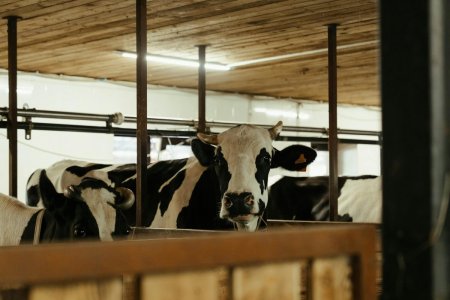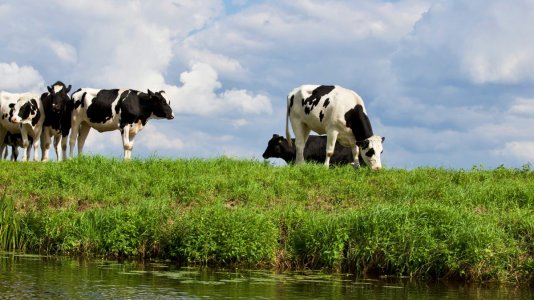Alarming discovery: Rare bird flu strain strikes dairy cows—what’s happening?
By
Aubrey Razon
- Replies 0
A shocking new bird flu strain has been found in dairy cows, catching the agricultural world off guard. This unexpected discovery has experts scrambling to understand the impact.
Could this threat shake up dairy production and your daily milk?
Traditionally, bird flu, also known as avian influenza, has been a concern primarily for poultry flocks.
However, this latest detection marks a significant shift in the behavior of the virus.
Until now, the 957 bird flu infections reported in dairy cow herds since the outbreak's inception last year were all attributed to a single strain of the virus.
The discovery of a second, distinct strain in dairy cattle suggests a worrying evolution of the disease.
The Centers for Disease Control and Prevention (CDC) has reported that nearly 70 people in the US, most of whom are farm workers, have contracted bird flu as the virus has spread among poultry and dairy herds.
This human toll underscores the importance of stringent biosecurity measures to protect those on the front lines of our food supply.
Moreover, the bird flu outbreak has had a devastating effect on egg-laying hens, resulting in the deaths of tens of millions of birds.
This loss has not only impacted the availability of eggs but has also driven egg prices to record highs, affecting consumers nationwide.
The announcement of the Animal and Plant Health and Inspection Service under the U.S. Department of Agriculture (USDA) came after genome sequencing of milk from Nevada identified the new strain in dairy cows for the first time.
This strain was the predominant genotype found in wild birds during the past fall and winter seasons.
The detection was part of the USDA's National Milk Testing Strategy, which began in December to monitor the spread of bird flu through milk testing across the country.
In response to the detections, the Nevada Department of Agriculture has placed herds in two counties under quarantine.
While the specific strain was not initially disclosed, it was known to be present in wild birds.

The USDA's swift action to contain the outbreak is critical to prevent the spread of this new strain to dairy cattle in other states.
Dr. Gail Hansen, a veterinary and public health consultant, emphasized the importance of learning from past experiences.
Last year, the virus spread nationwide after infected cattle were transported from Texas.
Hansen pointed out that cattle previously infected with the earlier strain may not have immunity against this new variant.
To mitigate the risk of interstate transmission, the USDA mandates that lactating dairy cattle be tested for bird flu before crossing state lines.
This measure is part of a broader strategy to safeguard the nation's livestock and, by extension, the food supply chain.
Also read: Could bird poop save you from the next flu pandemic?
For consumers, the immediate risk remains low, as bird flu is not typically transmitted through the consumption of milk or dairy products.
However, the broader implications for the dairy industry and food prices are yet to be fully understood.
The USDA and health authorities are closely monitoring the situation to ensure that appropriate steps are taken to protect both the agricultural sector and public health.
As members of The GrayVine community, it's essential to stay informed about these developments.
Understanding the impact of such outbreaks on our food system can help us make informed choices and support efforts to maintain a safe and secure food supply.
 Have you noticed changes in dairy or egg prices in your area? Are you concerned about the potential spread of this new bird flu strain? Share your thoughts with us in the comments below.
Have you noticed changes in dairy or egg prices in your area? Are you concerned about the potential spread of this new bird flu strain? Share your thoughts with us in the comments below.
Could this threat shake up dairy production and your daily milk?
Traditionally, bird flu, also known as avian influenza, has been a concern primarily for poultry flocks.
However, this latest detection marks a significant shift in the behavior of the virus.
Until now, the 957 bird flu infections reported in dairy cow herds since the outbreak's inception last year were all attributed to a single strain of the virus.
The discovery of a second, distinct strain in dairy cattle suggests a worrying evolution of the disease.
The Centers for Disease Control and Prevention (CDC) has reported that nearly 70 people in the US, most of whom are farm workers, have contracted bird flu as the virus has spread among poultry and dairy herds.
This human toll underscores the importance of stringent biosecurity measures to protect those on the front lines of our food supply.
Moreover, the bird flu outbreak has had a devastating effect on egg-laying hens, resulting in the deaths of tens of millions of birds.
This loss has not only impacted the availability of eggs but has also driven egg prices to record highs, affecting consumers nationwide.
The announcement of the Animal and Plant Health and Inspection Service under the U.S. Department of Agriculture (USDA) came after genome sequencing of milk from Nevada identified the new strain in dairy cows for the first time.
This strain was the predominant genotype found in wild birds during the past fall and winter seasons.
The detection was part of the USDA's National Milk Testing Strategy, which began in December to monitor the spread of bird flu through milk testing across the country.
In response to the detections, the Nevada Department of Agriculture has placed herds in two counties under quarantine.
While the specific strain was not initially disclosed, it was known to be present in wild birds.

The USDA is working to contain the outbreak to prevent it from spreading further. Image source: cottonbro studio/Pexels.
The USDA's swift action to contain the outbreak is critical to prevent the spread of this new strain to dairy cattle in other states.
Dr. Gail Hansen, a veterinary and public health consultant, emphasized the importance of learning from past experiences.
Last year, the virus spread nationwide after infected cattle were transported from Texas.
Hansen pointed out that cattle previously infected with the earlier strain may not have immunity against this new variant.
To mitigate the risk of interstate transmission, the USDA mandates that lactating dairy cattle be tested for bird flu before crossing state lines.
This measure is part of a broader strategy to safeguard the nation's livestock and, by extension, the food supply chain.
Also read: Could bird poop save you from the next flu pandemic?
For consumers, the immediate risk remains low, as bird flu is not typically transmitted through the consumption of milk or dairy products.
However, the broader implications for the dairy industry and food prices are yet to be fully understood.
The USDA and health authorities are closely monitoring the situation to ensure that appropriate steps are taken to protect both the agricultural sector and public health.
As members of The GrayVine community, it's essential to stay informed about these developments.
Understanding the impact of such outbreaks on our food system can help us make informed choices and support efforts to maintain a safe and secure food supply.
Key Takeaways
- The U.S. Department of Agriculture (USDA) has detected a new strain of bird flu in dairy cattle that was not previously observed in cows.
- This marks the first identification of a different strain in the 957 reported bird flu infections among dairy cow herds since the outbreak began.
- Nearly 70 people have contracted bird flu in the US, most of them farm workers, as a result of the virus spreading among poultry and dairy herds.
- The USDA is working to contain the outbreak to prevent it from spreading further, which includes testing lactating dairy cattle for bird flu before they are moved across state lines.






